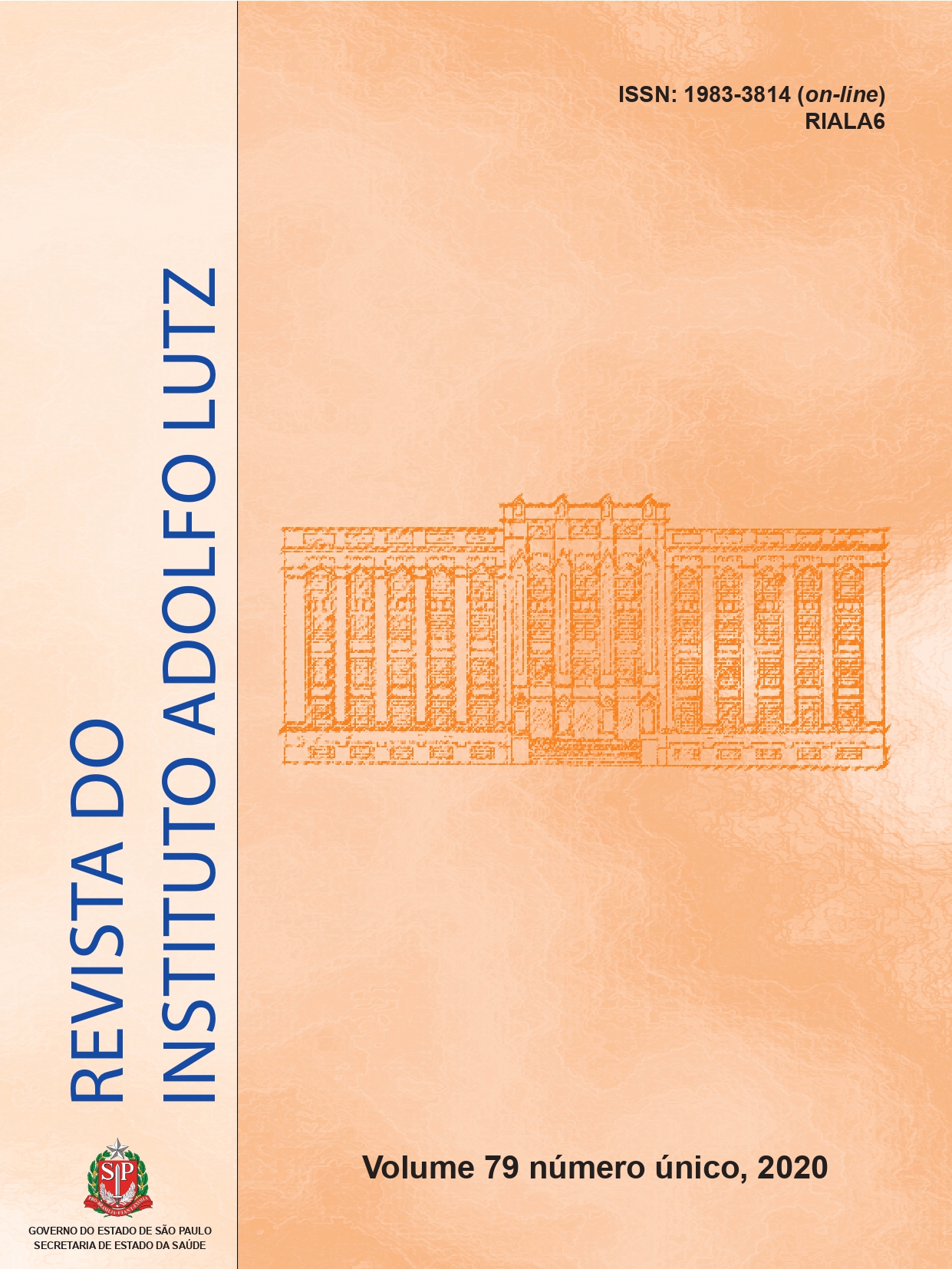Resumen
Micotoxinas são substâncias tóxicas produzidas por fungos e encontradas nos alimentos.
As micotoxinas mais tóxicas são as aflatoxinas, produzidas, principalmente por Aspergillus flavus.
Estudos realizados no país demonstraram alta incidência dessas micotoxinas em produtos de
amendoim, que representa risco à saúde da população. O objetivo do estudo foi avaliar a incidência
de aflatoxinas B1, B2, G1 e G2 em amostras de amendoins comercializados na região Nordeste do
Estado de São Paulo nos períodos de 1994-2001 e 2016-2017. O método utilizado para analisar as
amostras no primeiro período foi extração líquido-líquido e cromatografia em camada delgada e no
segundo foi utilizando colunas de imunoafinidade, cromatografia líquida com derivatização póscoluna
e detector por fluorescência. No levantamento de 1994-2001 das 82 amostras, 39% tiveram
contaminação de aflatoxinas variando de 11 a 1556 μg/kg com 37% das amostras contendo níveis
maiores que 20 μg/kg, enquanto na pesquisa de 2016-17, das 56 amostras, 38% apresentaram
contaminação destas toxinas variando de 0,09 a 60,40 μg/kg com 13% das amostras contendo níveis
maiores que 20 μg/kg. Os resultados dos dois períodos estudados indicam que houve uma diminuição
na incidência e nível das aflatoxinas estudadas, embora esta contaminação em amendoim permaneça
um problema de saúde pública.
Citas
1. Council for Agricultural Science and Technology (CAST). Mycotoxins: Risks in Plant, Animal, and Human Systems. Ames (IA): CAST; 2003.
2. International Agency for Research on Cancer (IARC). Evaluation of carcinogenic risks of chemicals to humans. Some naturally occurring substances. Food items and constituents. Heterocyclic aromatic amines and mycotoxins. Monographs, vol. 56. Lyon (France): IARC; 1993.
3. Cui A, Hua H, Shao T, Song P, Kong Q, Luo T et al. Aflatoxin B1 induces Src phosphorylation and stimulates lung cancer cell migration. Tumour Biol. 2015;36(8):6507-13. https://dx.doi. org/10.1007/s13277-015-3341-2
4. Hernandez-Vargas H, Castelino J, Silver MJ, Dominguez-Salas P, Cros MP, Durand G et al. Exposure to aflatoxin B1 in utero is associated with DNA methylation in white blood cells of infants in The Gambia. Int J Epidemiol. 2015;4(4):1238-48. https://doi.org/10.1093/ije/dyv027
5. Kew MK. Aflatoxins as a Cause of Hepatocellular Carcinoma. J Gastrointestin Liver Dis. 2013;22(3):305-10.
6. Liu Y, Chang CCH, Marsh GM, Wu F. Population attributable risk of aflatoxin-related liver cancer: systematic review and meta-analysis. Eur J Cancer. 2012;48(14):2125-36. https://doi.org/10.1016/j.ejca.2012.02.009
7. Kamika I, Takoy LL. Natural occurrence of Aflatoxin B1 in peanut collected from Kinshasa, Democratic Republic of Congo. Food Control. 2011;22(11):1760-4. https://doi.org/10.1016/j.foodcont.2011.04.010
8. Mutegi CK, Ngugi HK, Hendriks SL, Jones RB. Prevalence and factors associated with aflatoxin contamination of peanuts from Western Kenya. Int J Food Microbiol. 2009;130(1):27-34. https://doi.drg/10.1016/j.ijfoodmicro.2008.12.030
9. Kouadio JH, Lattanzio VM, Ouattara D, Kouakou B, Visconti A. Assessment of mycotoxin exposure in Côte d’ivoire (Ivory Coast) through multibiomarker analysis and possible correlation with food consumption patterns. Toxicol Int. 2014;21(3):248-57. https://doi.org/10.4103/0971-6580.155336
10. Santos AC, Souza AA, Silva MV, Nerilo SB, Souza APM, Bando E et al. Occurrence and exposure assessment to aflatoxins in peanuts commercialized in the northwest of Parana, Brazil. Ciênc Rural. 2018 48(6):e20170615. http://dx.doi.org/10.1590/0103-8478cr20170615
11. Martins LM, Sant’Ana AS, Fungaro MHP, Silva JJ, Nascimento MS, Frisvad JC et al. The biodiversity of Aspergillus section Flavi and aflatoxins in the Brazilian peanut production chain. Food Res Int. 2017;94:101-7. https://doi.org/10.1016/j.foodres.2017.02.006
12. Moreira MF, Oliveira TR, Vieira IGP, Freire FCO, Silva SC, Ribeiro LM et al. Occurrence of fungi and aflatoxins B in nuts and products marketed the Brazilian northeastern regions. Rev Inst Adolfo Lutz. 2016;75:e1698. Disponível em: http://www.ial.sp.gov.br/resources/insituto-adolfo-lutz/publicacoes/
rial/10/rial75_completa/artigos-separados/1698.pdf
13. Silva RA, Yakamoto IT, Ferreira LO, Marques LRM. Detecção e quantificação de aflatoxinas em amostras de grãos de amendoim e derivados comercializados na região de Marília- SP, 2002-2009. Braz J Food Nutr 2013;24(1):61-4. Disponível em: http://servbib.fcfar.unesp.br/seer/index.php/alimentos/article/view/2030/2030
14. Soares LM, Rodriguez-Amaya DB. Survey of aflatoxins, ochratoxin A, zearalenone, and sterigmatocystin in some Brazilian foods by using multi-toxin thin-layer chromatographic method. J Assoc Off Anal Chem. 1989;72(1):22-6.
15. Iha MH, Okada IA, Briganti RC, Mini CA, Trucksess MW. Aflatoxins in Brazilian peanut confection. J AOAC Int. 2016;99(3):830-4. https://doi.org/10.5740/jaoacint.15-0256
16. Berthiller F, Cramer B, Iha MH, Krska R, Lattanzio VMT, MacDonald S et al. Developments in mycotoxin analysis: an update for 2016-2017. World Mycotoxin J. 2018;11(1):5-32. https://doi.org/10.3920/WMJ2017.2250
17. AOAC International. Official Methods of Analysis of AOAC INTERNATIONAL. 18th ed., Gaithersburg (MD); 2010, Chapter 49, p. 1–51.
18. Ministério da Saúde (BR). Comissão Nacional de Normas e Padrões para Alimentos. Resolução - CNNPA nº 34, de 1976. Fixar para os alimentos, tolerâncias de 30ppb (trinta partes por bilhão) para as Aflatoxinas, calculada pela soma dos conteúdos das aflatoxinas B1 e G1. Diário Oficial da União. Brasília, DF, 19 jan 1977. Seção 1.
19. Ministério da Saúde (BR). Agência Nacional de Vigilância Sanitária. Resolução RDC n° 7, de 18 de fevereiro de 2011. Dispõe sobre limites máximos tolerados (LMT) para micotoxinas em alimentos. Diário Oficial da União. Brasília, DF, Seção 1(46):66.
20. Ministério da Saúde (BR). Agência Nacional de Vigilância Sanitária. Resolução RDC n° 7, 274, de 15 de outubro de 2002. Aprova o Regulamento Técnico Sobre Limites Máximos de Aflatoxinas Admissíveis no Leite, no Amendoim, no Milho, constante do Anexo desta Resolução. Diário Oficial da União. Brasília, DF, [acesso 2019 Ago 27]. Disponível em: http://bvsms.saude.gov.br/bvs/saudelegis/anvisa/2002/res0274_15_10_2002.html
21. Associação Brasileira da Indústria de Chocolates, Amendoim e Balas. A ABICAB e o Programa Pró-Amendoim. [acesso 2019 Ago 27]. Disponível em:
22. Facca MCL, Dalzoto PR. Aflatoxinas: um perfil da situação do amendoim e derivados no cenário brasileiro.Biológico. 2010;72(1):25-9.
23. Kaushik G. Effect of processing on mycotoxin content in grains., Crit Rev Food Sci Nutr. 2015;55(12):1672-83.

Esta obra está bajo una licencia internacional Creative Commons Atribución 4.0.
Derechos de autor 2020 Maria Helena IHA Matias, Marcelo Ferreira da Cruz, Isaura Akemi Okada, Rita de Cássia Briganti, Maria Aparecida de Oliveira
